Key takeaways:
- Feature engineering is essential for improving model performance by selecting and transforming relevant features, influenced by deep data understanding.
- Challenges in feature engineering include handling missing data, selecting significant features, and the iterative nature of the process that requires persistence and creativity.
- Effective feature transformation techniques, such as normalization and encoding, can significantly enhance model predictions by capturing relationships in the data.
- Collaboration and asking the right questions about the data can lead to identifying meaningful features and improving model accuracy.
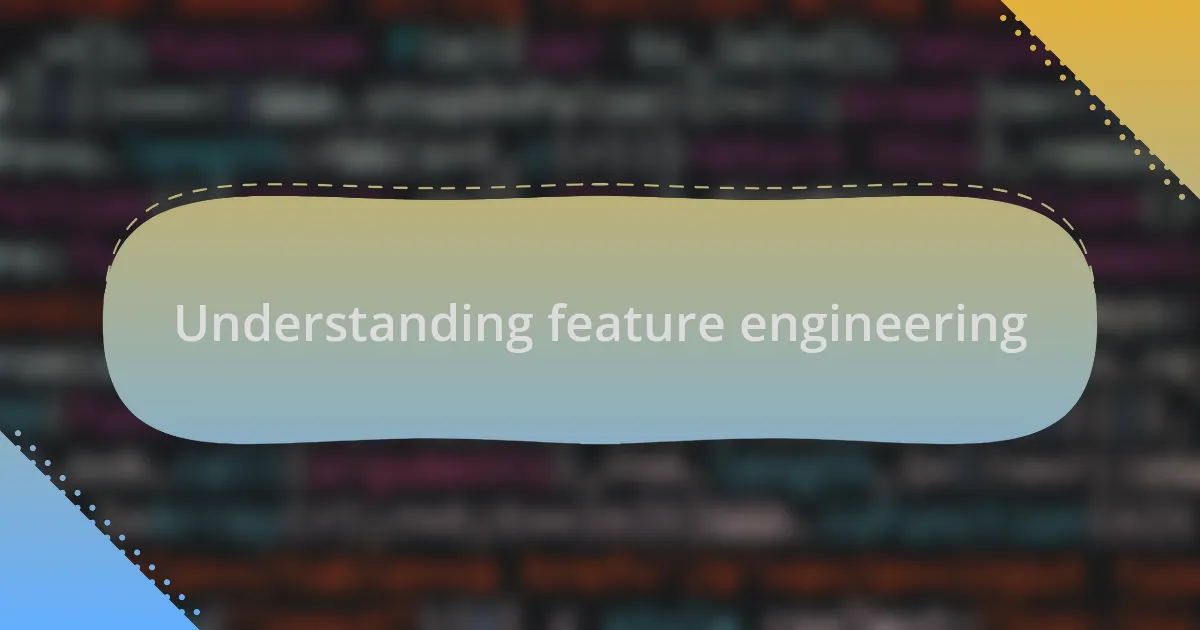
Understanding feature engineering
Feature engineering is a pivotal step in the machine learning process, often determining the success of a model. I remember when I first encountered it; I felt overwhelmed by the sheer number of possibilities. I found myself asking, “How do I choose the right features?” The answer lies in understanding the data deeply and knowing how changes can impact outcomes.
As I delved deeper into feature engineering, I realized it’s not just about selecting variables but also transforming them for better model performance. For instance, I once took a basic dataset of house prices and created new features like price per square foot and age of the house. This simple act not only improved my model’s accuracy but also gave me a sense of accomplishment—like discovering hidden gems in the data.
Moreover, the emotional rollercoaster that comes with trial and error in feature engineering is quite enlightening. There was a project where I underestimated the importance of categorical variables. After disappointing results, I completely reassessed my approach. It hit me that the right features can turn a mediocre model into a game-changer. Do you ever think about how much potential lies hidden in your datasets? Embracing the nuances of feature engineering can lead to those “aha” moments that redefine your projects.
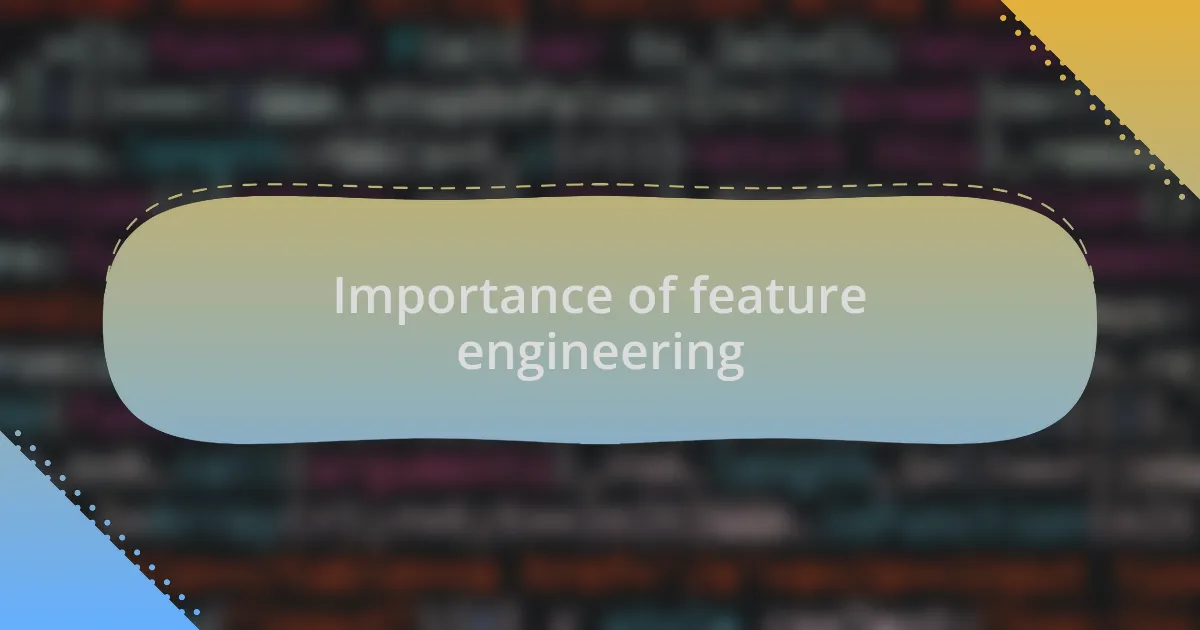
Importance of feature engineering
Feature engineering is crucial because it directly impacts the predictive power of machine learning models. I recall a time when I underestimated how crucial it was to extract relevant features from a health dataset. Initially, my model’s predictions were all over the place until I isolated key indicators such as age and fitness levels. Suddenly, the impact of those features became clear, transforming my model into a more reliable tool.
When working on a social media analysis project, I learned that the features I chose were reflective not just of data points, but of human behavior. By including sentiment scores as a feature, I could better understand user engagement and trends. This insight truly hit home for me—the realization that thoughtful feature engineering isn’t just about algorithms; it’s about understanding the story behind the numbers.
I often find myself questioning how much data we take for granted without exploring its depths. Each dataset has a unique fingerprint, and with the right features, we can uncover patterns that not only enhance our models but also provide meaningful insights into real-world problems. The thrill of discovering how subtle changes can lead to significant improvements keeps me passionate about this craft. What hidden stories could your data reveal if you only took the time to dig a little deeper?
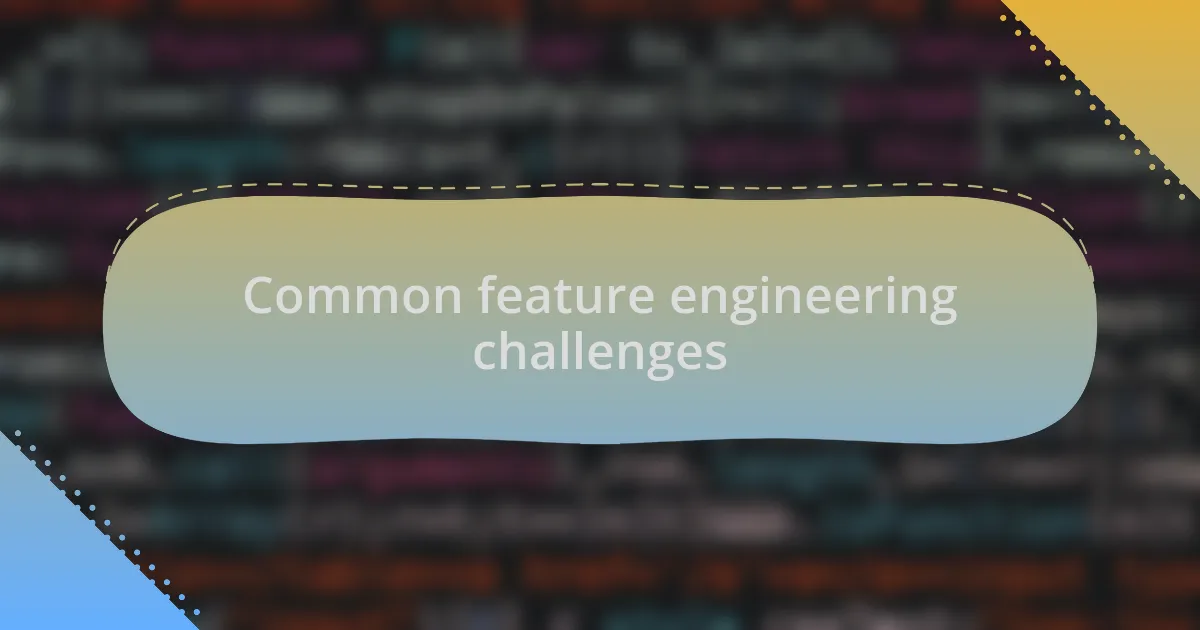
Common feature engineering challenges
When diving into feature engineering, one common challenge I frequently face is dealing with missing data. In one of my earlier projects involving customer purchase history, I discovered that many records were incomplete. After struggling for days to make sense of the models, I realized that simply ignoring those entries was insufficient. I had to devise strategies such as imputation techniques or considering alternatives like using frequency counts, which ultimately led to more robust predictions.
Another hurdle that can be quite daunting is selecting the right features from a vast pool of possibilities. I remember working on a project centered around real estate price prediction where I was overwhelmed by the number of potential indicators—location, square footage, and amenities, to name a few. It was like standing at a buffet and not knowing what to choose! The solution came from using feature importance scores that helped me prioritize elements that truly contributed to the model’s accuracy. This experience reinforced my belief that a well-informed selection can make all the difference in performance.
Lastly, I find that the constant iteration required in feature engineering can be exhausting yet exhilarating. For instance, during a recent challenge with a time-series forecasting model, I felt a mix of frustration and anticipation as I tweaked different time-lagged features. Each trial was a lesson in patience, pushing boundaries while I tried to capture trends more effectively. I often ask myself: how do we find the perfect balance between creativity and rigor in this iterative process? It’s a fine line, but I’ve learned that persistence often leads to serendipitous breakthroughs in model performance.
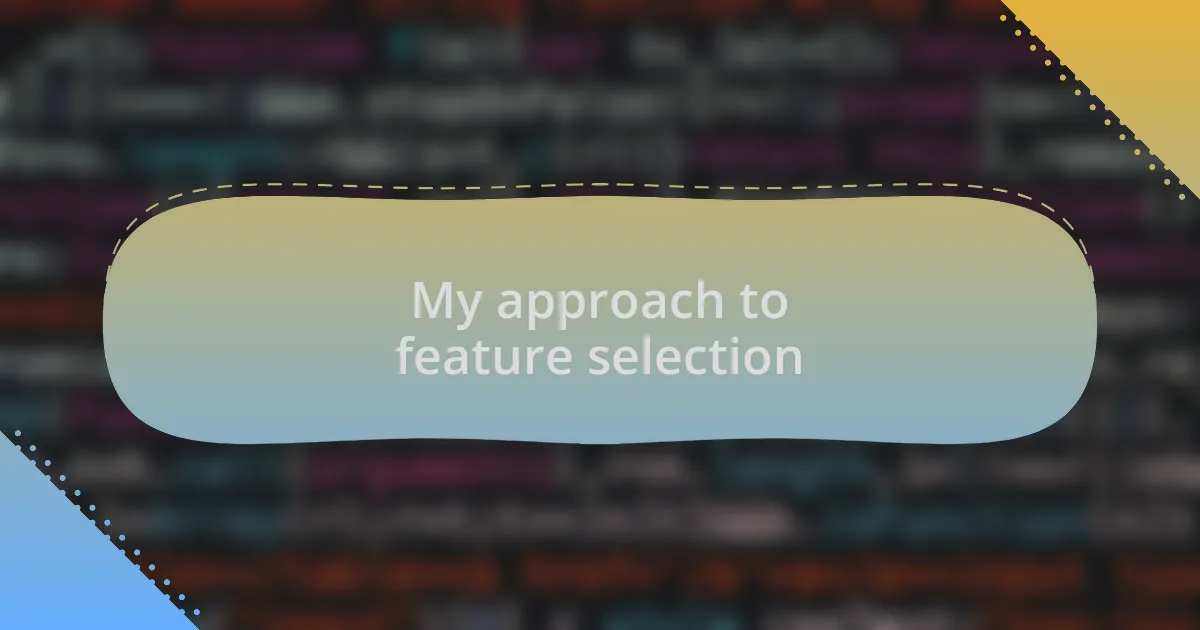
My approach to feature selection
When it comes to feature selection, I usually start with a solid understanding of the problem I am trying to solve. For instance, in a recent project about predicting student performance based on various educational metrics, I found myself yearning for clarity among the sheer number of variables. I began by closely analyzing which features directly aligned with the academic outcomes I was interested in, which not only streamlined my selection but also made me feel more confident in the chosen indicators.
Moreover, I often use visualization techniques to help me identify relationships and importance among features. I vividly recall one instance when I plotted a correlation matrix for a dataset involving telecommunications—seeing how features like call duration and contract type were interrelated really illuminated the path for selection. It’s fascinating how visualizing the data can bring out patterns that might otherwise remain hidden. Have you ever had a moment where a simple graph changed your entire understanding of a dataset? For me, those moments are incredibly rewarding.
As I work through feature selection, I also embrace the power of domain knowledge. I remember collaborating with a healthcare expert while predicting patient readmissions. Their insights about which factors were truly impactful reshaped my approach to feature selection entirely. It made me realize that technical expertise paired with domain understanding can lead to richer, more effective models. Without that synergy, I might have overlooked vital aspects that truly drive outcomes. Each experience reinforces the idea that selecting features is not just a technical task; it’s a blend of art and science.
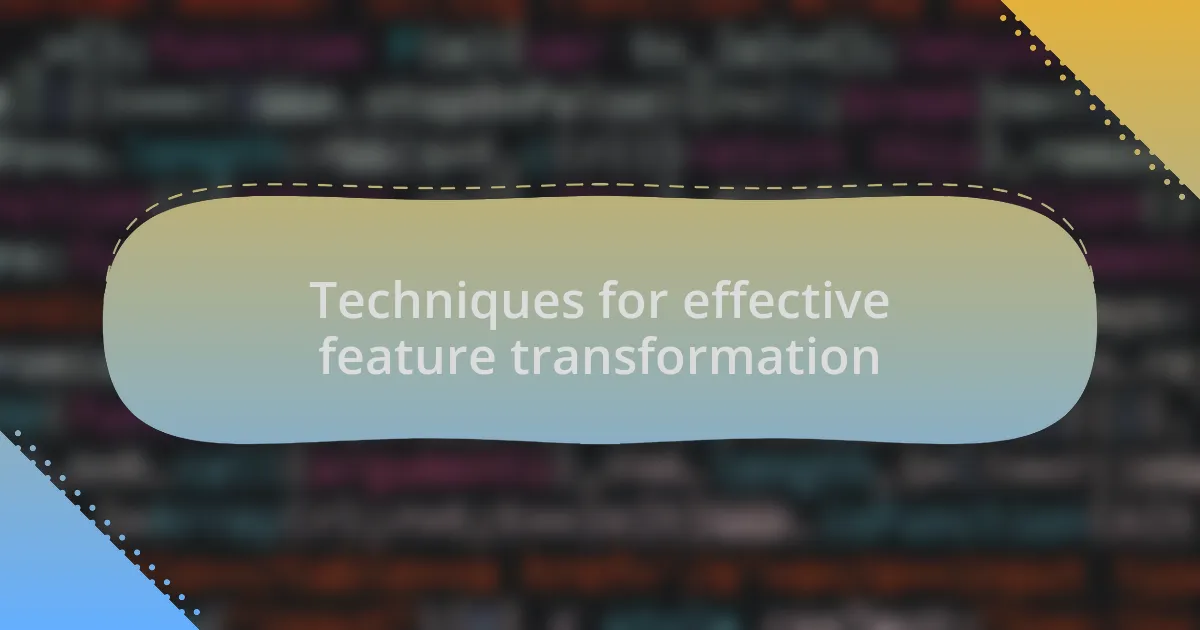
Techniques for effective feature transformation
Effective feature transformation is key to enhancing the predictive power of any model. One technique I frequently rely on is normalization, especially when dealing with features that have vastly different scales. I recall working on a project where I had features like age and salary—the disparity was staggering. Once I standardized them, the model began to perform significantly better. Have you noticed how the smallest adjustments can sometimes yield the most dramatic results?
Another useful technique is encoding categorical variables, which I often approach with a careful balance between one-hot encoding and label encoding. In a retail analytics project, for instance, I experimented with one-hot encoding for product categories. Initially, the high dimensionality felt overwhelming. But once I tuned my model, I realized how effectively those transformed features captured customer preferences—each encoded variable added clarity to the customer behavior puzzle. What have you found works best for turning categorical data into usable features?
Lastly, I’ve found that applying polynomial features can reveal intricate relationships in the data that simple linear transformations might overlook. In a recent analysis into consumer loan approvals, including squared and interaction terms allowed me to capture non-linear relationships between the amount requested and the applicant’s credit score. It was eye-opening to witness how these additional features transformed the model’s predictions, almost like finding hidden connections in a seemingly straightforward dataset. Have you ever stumbled upon a transformation that completely shifted your understanding of the problem? Those revelations are what keep me passionate about data science.
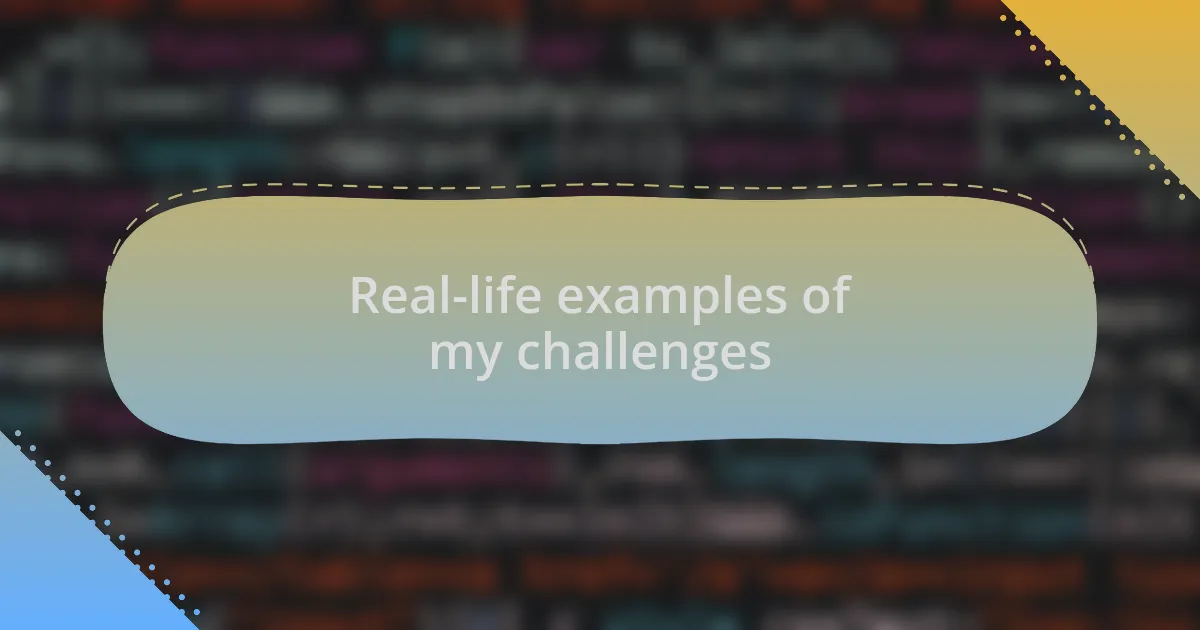
Real-life examples of my challenges
There was a time when I faced a significant challenge while working on a project that involved predicting housing prices. Initially, I struggled with an overwhelming number of features, some of which were not contributing anything meaningful to the model. It was frustrating, to say the least. However, once I implemented feature selection techniques and eliminated redundant variables, the clarity of my predictions improved dramatically. Do you remember a moment when simplifying your data made all the difference?
In another project focused on customer churn, I discovered that simply relying on historical data wasn’t enough. I had to create features that captured customer engagement over time. This meant diving deep into time-series analysis, a daunting task that initially felt insurmountable. Yet, by measuring metrics like weekly logins and purchase frequency, I crafted a fuller picture of customer behavior. Have you ever felt the satisfaction of crafting something complex into something understandable?
Once, while analyzing social media sentiment for a client, I realized that the text data was a goldmine, but harnessing it was another story. The challenge came from extracting meaningful features from unstructured text. It was grueling to sift through inexact expressions and slang. Yet, when I implemented natural language processing techniques, such as term frequency-inverse document frequency (TF-IDF), it sparked a turning point for my insights. Have you ever seen a jumble of words transform into actionable insights? That blending of creativity with analytical thinking is what fuels my passion for feature engineering.
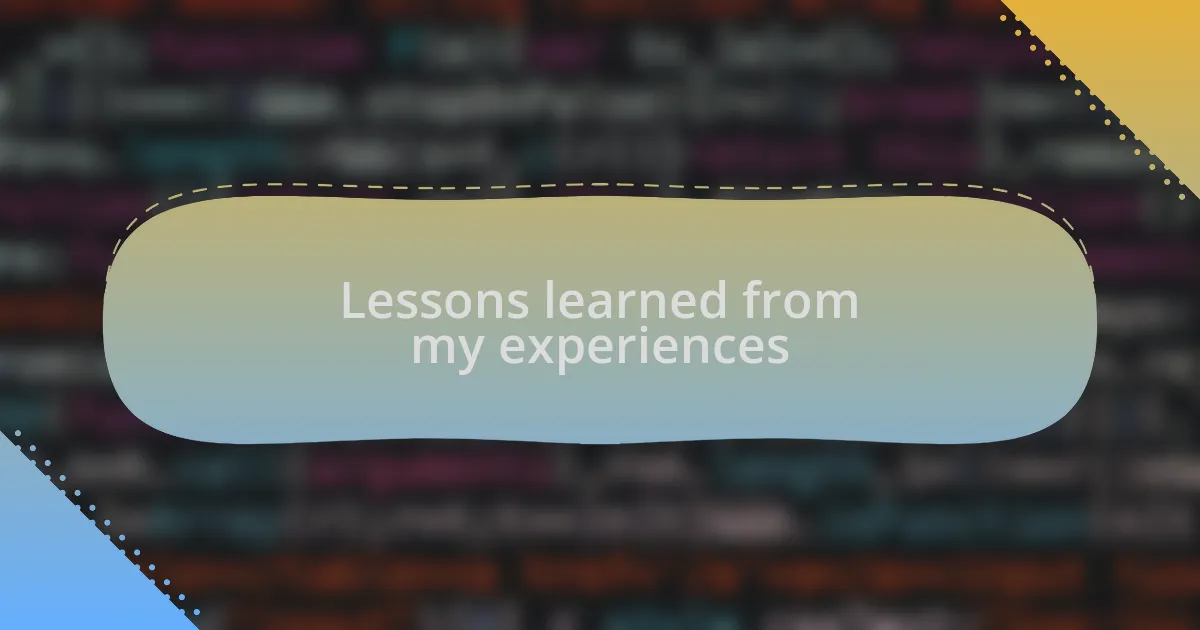
Lessons learned from my experiences
During my journey with feature engineering, one pivotal lesson I learned was the importance of asking the right questions about my data. There was a project where I found myself overwhelmed by the sheer volume of features. Instead of diving straight into processing, I took a step back and asked myself, “What story do I want my data to tell?” This simple shift in perspective led me to prioritize features that were truly relevant, allowing me to focus on quality rather than quantity.
Another eye-opening experience occurred when I was tasked with forecasting sales for a seasonal product. Initially, my models performed dismally due to ignoring seasonal trends. This oversight made me realize how crucial it is to understand the domain of the data. By integrating features that accounted for seasonality, like holidays and local events, I saw significant improvements in my predictions. Have you ever experienced that moment of realization when the pieces finally fall into place?
I also learned the hard way that collaboration can enhance feature engineering outcomes. While working in a team, I frequently consulted with colleagues from different backgrounds. Their diverse perspectives helped me identify feature ideas I would have overlooked on my own. It’s funny how sometimes the most valuable insights come from simply sharing thoughts over a cup of coffee. Have you ever felt your understanding deepened through a casual conversation? Building those connections really does enrich the entire process.